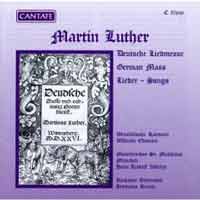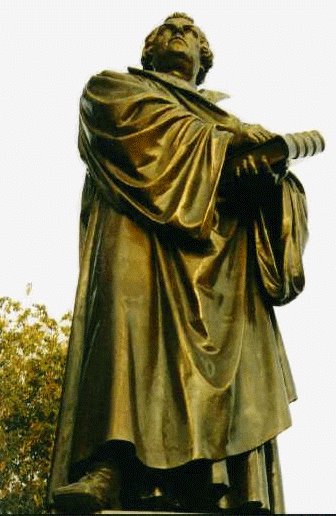01 July 2006
Three Discs of Medieval Lutheran Music
Over the last several trips to Houston I was able to check out three CDs.
 Martin Luther und die Musik has good performances and is well recorded; some CDs like Praetorius' Christmas Mass sound like the gain has been cranked too much on the microphone. Only a few of the eighteen tracks are hymns I recognized. "Ein Feste Burg" ("A Mighty Fortress") is strong, but "Vater Unser" ("Our Father Who In Heaven Above") and "Wir gläuben all an einen Gott" ("We All Believe in One True God") are single stanza organ instrumentals. An Amazon reviewer recommends getting it for "Beati Immaculati", and I agree, the running cadences are beautiful. For congregational singing of familiar hymns, though, I was forced to look elsewhere.
Martin Luther und die Musik has good performances and is well recorded; some CDs like Praetorius' Christmas Mass sound like the gain has been cranked too much on the microphone. Only a few of the eighteen tracks are hymns I recognized. "Ein Feste Burg" ("A Mighty Fortress") is strong, but "Vater Unser" ("Our Father Who In Heaven Above") and "Wir gläuben all an einen Gott" ("We All Believe in One True God") are single stanza organ instrumentals. An Amazon reviewer recommends getting it for "Beati Immaculati", and I agree, the running cadences are beautiful. For congregational singing of familiar hymns, though, I was forced to look elsewhere.
 Deutsche Liedmesse (German Hymn Mass) is closer to what I've been looking for. It had gotten a lot of play in my car stereo in Houston. It also is well performed and well mastered. Less people sing "Ein Feste Burg" than in the previous CD, but the higher parts brighten the hymn significantly. Nine of the 14 tracks are recognizable hymns; someone please listen to the Gloria sample from Amazon and tell me the name of that tune. :) "Nun freut euch, lieben Christen" ("Dear Christian People All, Rejoice") has good variety among the verses, employing boy choir and male solo. "Vater Unser" this time is sung and sung well, and classical enthusiasts may give the volume knob an extra touch. This is a great CD for hymns in German.
Deutsche Liedmesse (German Hymn Mass) is closer to what I've been looking for. It had gotten a lot of play in my car stereo in Houston. It also is well performed and well mastered. Less people sing "Ein Feste Burg" than in the previous CD, but the higher parts brighten the hymn significantly. Nine of the 14 tracks are recognizable hymns; someone please listen to the Gloria sample from Amazon and tell me the name of that tune. :) "Nun freut euch, lieben Christen" ("Dear Christian People All, Rejoice") has good variety among the verses, employing boy choir and male solo. "Vater Unser" this time is sung and sung well, and classical enthusiasts may give the volume knob an extra touch. This is a great CD for hymns in German.
 Seeking something auf Englisch I came across a CD published by the American Lutheran Publicity Bureau. "Through the Church Year With the Best in Lutheran Hymns" is an excellent instructional tool. The CD comes in a pocket on the inside back cover of a 8½ in. x 11 in. There are four pages of introductory essays. There are words, melody, and scriptural references for all 18 hymns. I would have preferred that they print all parts instead of just the melody, but the book would have been bigger.
Seeking something auf Englisch I came across a CD published by the American Lutheran Publicity Bureau. "Through the Church Year With the Best in Lutheran Hymns" is an excellent instructional tool. The CD comes in a pocket on the inside back cover of a 8½ in. x 11 in. There are four pages of introductory essays. There are words, melody, and scriptural references for all 18 hymns. I would have preferred that they print all parts instead of just the melody, but the book would have been bigger.
This CD is a remaster of a 40-year-old audio recording. There are points of distortion even with digital tweaking. Most recordings of hymns start with the congregation singing the first verse and then choirs or solos follow; these hymns typically start with the first verse in four-part choir, the second verse in choral unison, and then the congregation comes in on verse three or four. In these situations the lyrics to the first couple of verses are written above the sheet music which contains the congregational verse. For their 50th Anniversary edition I would consider recording the hymns with present-day performers and recording technology, and letting the congregation start verse 1. :)
Originally posted on Necessary Roughness on July 1, 2006.
Feedback
Over the last several trips to Houston I was able to check out three CDs.
 Martin Luther und die Musik has good performances and is well recorded; some CDs like Praetorius' Christmas Mass sound like the gain has been cranked too much on the microphone. Only a few of the eighteen tracks are hymns I recognized. "Ein Feste Burg" ("A Mighty Fortress") is strong, but "Vater Unser" ("Our Father Who In Heaven Above") and "Wir gläuben all an einen Gott" ("We All Believe in One True God") are single stanza organ instrumentals. An Amazon reviewer recommends getting it for "Beati Immaculati", and I agree, the running cadences are beautiful. For congregational singing of familiar hymns, though, I was forced to look elsewhere.
Martin Luther und die Musik has good performances and is well recorded; some CDs like Praetorius' Christmas Mass sound like the gain has been cranked too much on the microphone. Only a few of the eighteen tracks are hymns I recognized. "Ein Feste Burg" ("A Mighty Fortress") is strong, but "Vater Unser" ("Our Father Who In Heaven Above") and "Wir gläuben all an einen Gott" ("We All Believe in One True God") are single stanza organ instrumentals. An Amazon reviewer recommends getting it for "Beati Immaculati", and I agree, the running cadences are beautiful. For congregational singing of familiar hymns, though, I was forced to look elsewhere. Deutsche Liedmesse (German Hymn Mass) is closer to what I've been looking for. It had gotten a lot of play in my car stereo in Houston. It also is well performed and well mastered. Less people sing "Ein Feste Burg" than in the previous CD, but the higher parts brighten the hymn significantly. Nine of the 14 tracks are recognizable hymns; someone please listen to the Gloria sample from Amazon and tell me the name of that tune. :) "Nun freut euch, lieben Christen" ("Dear Christian People All, Rejoice") has good variety among the verses, employing boy choir and male solo. "Vater Unser" this time is sung and sung well, and classical enthusiasts may give the volume knob an extra touch. This is a great CD for hymns in German.
Deutsche Liedmesse (German Hymn Mass) is closer to what I've been looking for. It had gotten a lot of play in my car stereo in Houston. It also is well performed and well mastered. Less people sing "Ein Feste Burg" than in the previous CD, but the higher parts brighten the hymn significantly. Nine of the 14 tracks are recognizable hymns; someone please listen to the Gloria sample from Amazon and tell me the name of that tune. :) "Nun freut euch, lieben Christen" ("Dear Christian People All, Rejoice") has good variety among the verses, employing boy choir and male solo. "Vater Unser" this time is sung and sung well, and classical enthusiasts may give the volume knob an extra touch. This is a great CD for hymns in German. Seeking something auf Englisch I came across a CD published by the American Lutheran Publicity Bureau. "Through the Church Year With the Best in Lutheran Hymns" is an excellent instructional tool. The CD comes in a pocket on the inside back cover of a 8½ in. x 11 in. There are four pages of introductory essays. There are words, melody, and scriptural references for all 18 hymns. I would have preferred that they print all parts instead of just the melody, but the book would have been bigger.
Seeking something auf Englisch I came across a CD published by the American Lutheran Publicity Bureau. "Through the Church Year With the Best in Lutheran Hymns" is an excellent instructional tool. The CD comes in a pocket on the inside back cover of a 8½ in. x 11 in. There are four pages of introductory essays. There are words, melody, and scriptural references for all 18 hymns. I would have preferred that they print all parts instead of just the melody, but the book would have been bigger.This CD is a remaster of a 40-year-old audio recording. There are points of distortion even with digital tweaking. Most recordings of hymns start with the congregation singing the first verse and then choirs or solos follow; these hymns typically start with the first verse in four-part choir, the second verse in choral unison, and then the congregation comes in on verse three or four. In these situations the lyrics to the first couple of verses are written above the sheet music which contains the congregational verse. For their 50th Anniversary edition I would consider recording the hymns with present-day performers and recording technology, and letting the congregation start verse 1. :)
Originally posted on Necessary Roughness on July 1, 2006.
Feedback


